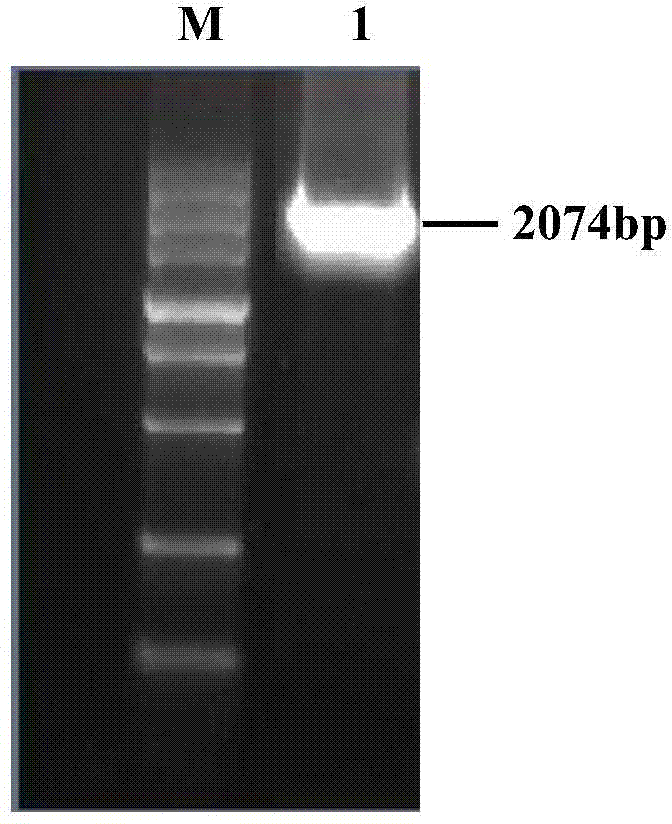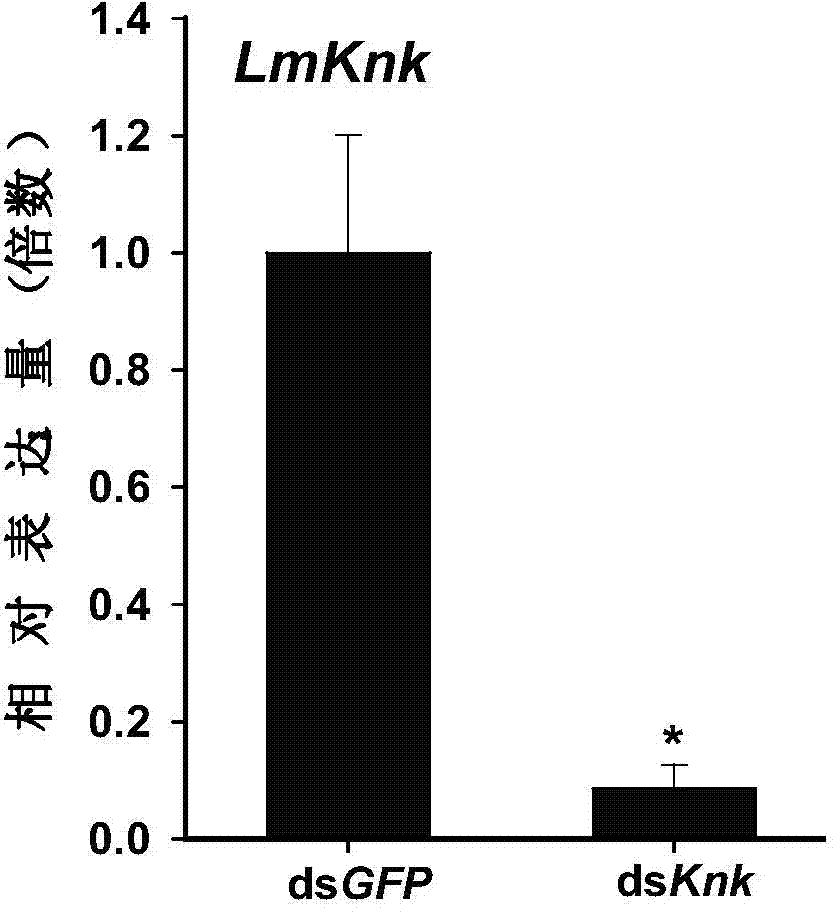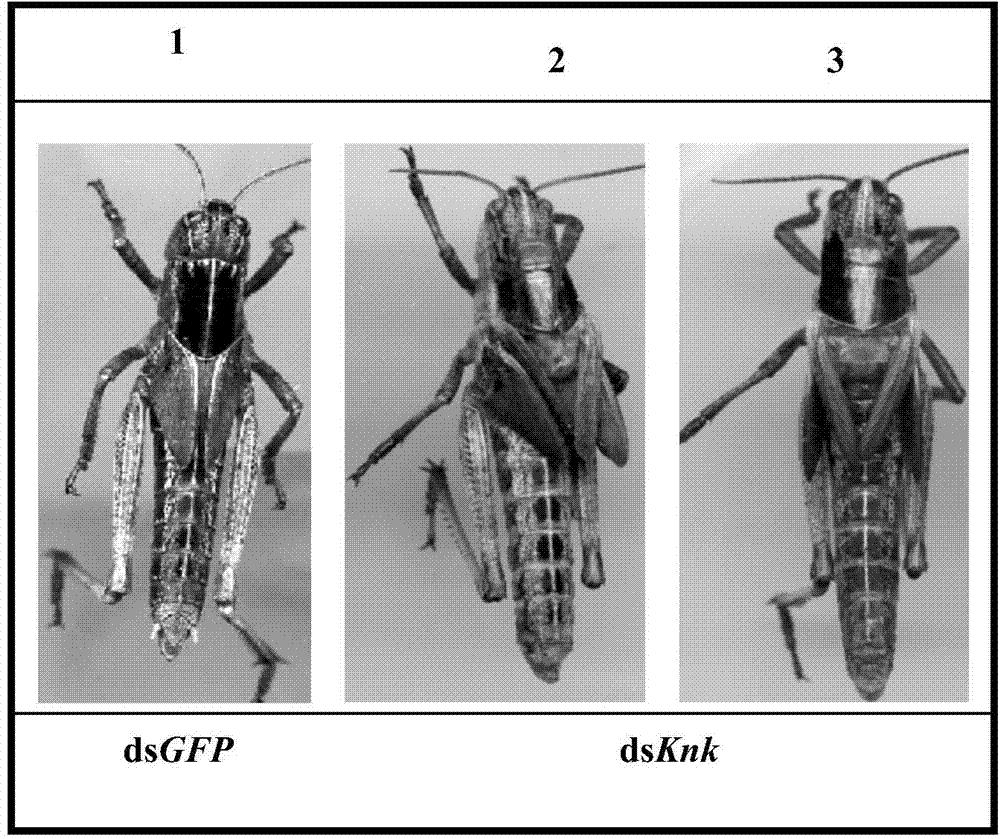Application of Knickkopf gene dsRNA in pest control
A technology of genes and gene fragments, which is applied in the application field of migratory locust knockkopf gene dsRNA in pest control, can solve the problems of insect molting retardation, epidermal chitin arrangement disorder, etc., and achieve the effect of high lethality
- Summary
- Abstract
- Description
- Claims
- Application Information
AI Technical Summary
Problems solved by technology
Method used
Image
Examples
Embodiment 1
[0015] Example 1: Acquisition of full-length cDNA of migratory locust Knk gene and prediction of amino acids
[0016] 1. Search for Knk gene fragments in migratory locusts
[0017] Unigene search was carried out from the transcriptome database of migratory locusts, and then analyzed by NCBI Blastx online software, and a Knk gene fragment of migratory locusts was determined to be obtained.
[0018] 2. Acquisition of full-length cDNA of migratory locust Knk gene
[0019] 1) Design of primers required for PCR amplification:
[0020] The GeneDoc software was used to splice and compare the Knk gene fragments obtained from the search, and the primer premier5.0 software was used to design the upstream primer AAGAAATGCACGAATTAGCAATATG (SEQ ID NO: 3) and the downstream primer TTAACACTAATTTTGCATCACAGTCC (SEQ ID NO: 4). The designed primers were sent to Shanghai Yingwei Jieji Biological Co., Ltd. for synthesis.
[0021] 2) Template preparation required for PCR amplification:
[0022]...
Embodiment 2
[0027] Embodiment 2: the dsRNA synthesized by migratory locust Knk gene fragment
[0028] 1. Primers required for dsRNA synthesis of migratory locust Knk gene fragment
[0029] Based on the nucleotide sequence SEQ ID NO: 1 of the migratory locust Knk gene obtained by sequencing, a pair of primers required for synthesizing dsRNA was designed using primer premier5.0 software. The sequences taatacgactcactatagggAACATCACGGCTCAGTCT CC (SEQ ID NO: 5) and taatacgactcactatagggGGGAACCAAGTAGCCATTGA (SEQ ID NO: 6) are the upstream and downstream primers, respectively. (The part in italics is the T7 promoter). The designed primers were sent to Shanghai Yingwei Jieji Biological Co., Ltd. for synthesis.
[0030] 2. Template preparation for dsRNA synthesis of migratory locust Knk gene fragment
[0031] The designed and synthesized primers (all containing the T7 promoter sequence) for the synthesis of dsRNA were subjected to PCR amplification to obtain a fragment with a length of 538 bp. I...
Embodiment 3
[0034] Embodiment 3: The lethal experiment of migratory locust Knk gene fragment synthetic dsRNA to migratory locust
[0035] 1. Injection of dsRNA synthesized by migratory locust Knk gene fragment
[0036] Pick 25 5th-instar 2-day-old nymphs with good growth, uniform size, and half male and half male for dsRNA injection. The worms injected with dsGFP were set as the control group, and the dsRNA (dsKnk) synthesized by the knk gene fragment was set as the experimental group. Gently inject 2.5 μl (6.25 μg) of dsKnk into the body cavity of the migratory locust along the contraction direction of the abdomen of the migratory locust using a micro-injector. Simultaneously pick the same number of healthy nymphs and inject the same amount of dsGFP. After the injection, the two groups of nymphs were placed under the same conditions (light:dark time=14h:10h, temperature 30±2°C, humidity 60%). Feed sufficient fresh wheatgrass and wheat bran.
[0037] 2. Detection of mRNA expression of...
PUM
 Login to View More
Login to View More Abstract
Description
Claims
Application Information
 Login to View More
Login to View More - R&D
- Intellectual Property
- Life Sciences
- Materials
- Tech Scout
- Unparalleled Data Quality
- Higher Quality Content
- 60% Fewer Hallucinations
Browse by: Latest US Patents, China's latest patents, Technical Efficacy Thesaurus, Application Domain, Technology Topic, Popular Technical Reports.
© 2025 PatSnap. All rights reserved.Legal|Privacy policy|Modern Slavery Act Transparency Statement|Sitemap|About US| Contact US: help@patsnap.com



